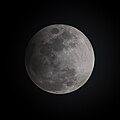February 2017 lunar eclipse
This article may require cleanup to meet Wikipedia's quality standards. The specific problem is: external links could be references. (April 2017) |
| Penumbral eclipse | |||||||||
 From Rabka-Zdrój, Poland, 0:51 UTC | |||||||||
| Date | 11 February 2017 | ||||||||
|---|---|---|---|---|---|---|---|---|---|
| Gamma | −1.0254 | ||||||||
| Magnitude | 0.9884 | ||||||||
| Saros cycle | 114 (59 of 71) | ||||||||
| Penumbral | 259 minutes, 10 seconds | ||||||||
| |||||||||
A penumbral lunar eclipse took place at the Moon's ascending node on 11 February 2017, the first of two lunar eclipses in 2017. It was not quite a total penumbral lunar eclipse. It occurred the same day as comet 45P/Honda–Mrkos–Pajdušáková made a close approach to Earth (0.08318 AU). It also occurred on the Lantern Festival, the first since 9 February 2009. Occurring only 4.4 days after perigee (Perigee on 6 February 2017), the moon's apparent diameter was larger.
Visibility
[edit]It was visible from the Americas, Europe, Africa, and most of Asia.
 
|
 Visibility map |
Gallery
[edit]-
Popayán, Colombia, 23:43 UTC (10 February)
-
Kissimmee, Florida, 0:00 UTC
-
Tampa, Florida, 0:11 UTC
-
Time lapse images from Melbourne, Florida
-
Bracciano, Italy, 0:29 UTC
-
Macon, Georgia, 0:38 UTC
-
Naperville, Illinois, 1:23 UTC
-
Innsbruck, Austria, ~2:00 UTC
Related eclipses
[edit]Eclipses of 2017
[edit]- A penumbral lunar eclipse on 11 February.
- An annular solar eclipse on 26 February.
- A partial lunar eclipse on 7 August.
- A total solar eclipse on 21 August.
Lunar year series
[edit]| Lunar eclipse series sets from 2016–2020 | ||||||||
|---|---|---|---|---|---|---|---|---|
| Descending node | Ascending node | |||||||
| Saros | Date | Type Viewing |
Gamma | Saros | Date Viewing |
Type Chart |
Gamma | |
| 109 | 2016 Aug 18
|
Penumbral
|
1.56406 | 114
|
2017 Feb 11
|
Penumbral
|
−1.02548 | |
119
|
2017 Aug 07
|
Partial
|
0.86690 | 124
|
2018 Jan 31
|
Total
|
−0.30143 | |
129
|
2018 Jul 27
|
Total
|
0.11681 | 134
|
2019 Jan 21
|
Total
|
0.36842 | |
139
|
2019 Jul 16
|
Partial
|
−0.64300 | 144
|
2020 Jan 10
|
Penumbral
|
1.07270 | |
| 149 | 2020 Jul 05
|
Penumbral
|
−1.36387 | |||||
| Last set | 2016 Sep 16 | Last set | 2016 Mar 23 | |||||
| Next set | 2020 Jun 05 | Next set | 2020 Nov 30 | |||||
Saros series
[edit]It is part of Saros cycle 114.
Lunar Saros series 114, repeating every 18 years and 11 days, has a total of 71 lunar eclipse events including 13 total lunar eclipses.
First Penumbral Lunar Eclipse: 0971 May 13
First Partial Lunar Eclipse: 1115 Aug 07
First Total Lunar Eclipse: 1458 Feb 28
First Central Lunar Eclipse: 1530 Apr 12
Greatest Eclipse of Lunar Saros 114: 1584 May 24
Last Central Lunar Eclipse: 1638 Jun 26
Last Total Lunar Eclipse: 1674 Jul 17
Last Partial Lunar Eclipse: 1890 Nov 26
Last Penumbral Lunar Eclipse: 2233 Jun 22
Half-Saros cycle
[edit]A lunar eclipse will be preceded and followed by solar eclipses by 9 years and 5.5 days (a half saros).[1] This lunar eclipse is related to two annular solar eclipses of Solar Saros 121.
| 7 February 2008 | 17 February 2026 |
|---|---|

|

|
Tritos series
[edit]- Preceded: Lunar eclipse of March 14, 2006
- Followed: Lunar eclipse of January 12, 2028
Tzolkinex
[edit]- Preceded: Lunar eclipse of December 31, 2009
- Followed: Lunar eclipse of March 25, 2024
See also
[edit]References
[edit]- ^ Mathematical Astronomy Morsels, Jean Meeus, p.110, Chapter 18, The half-saros
External links
[edit]- 2017 Feb 11 chart: Eclipse Predictions by Fred Espenak, NASA/GSFC
- 11 Feb 2017 - Penumbral Lunar Eclipse - Penumbral Lunar Eclipse
- Pakistan to witness lunar eclipse on February 11









